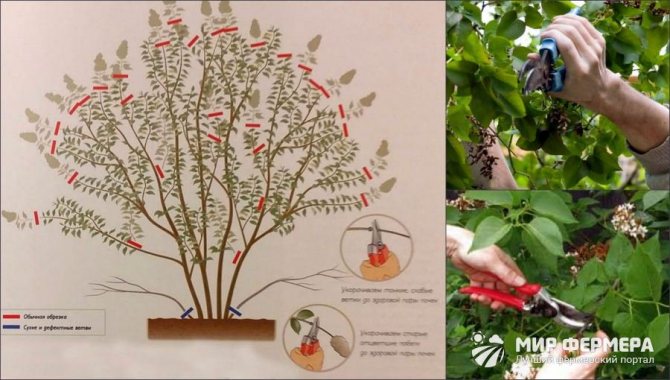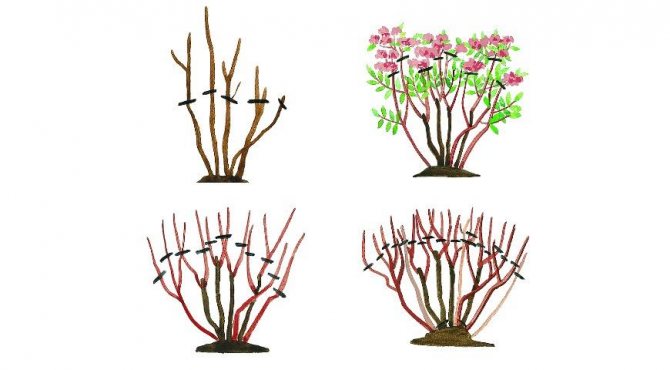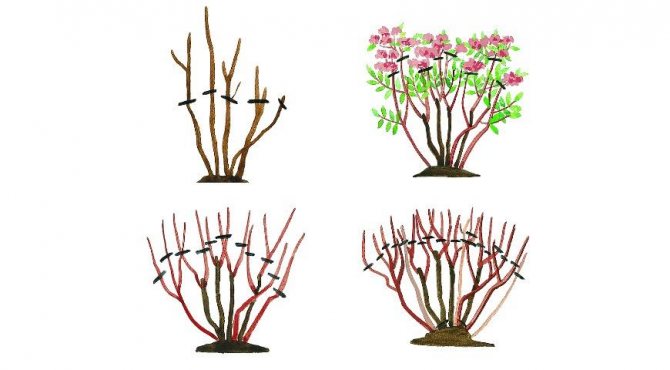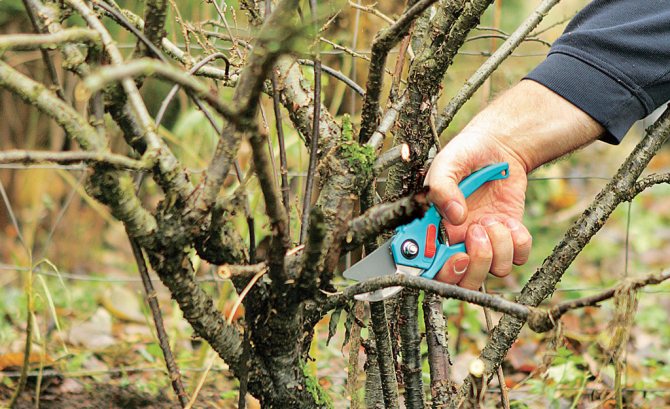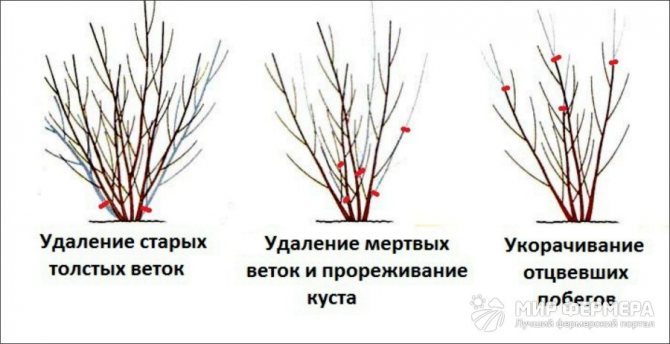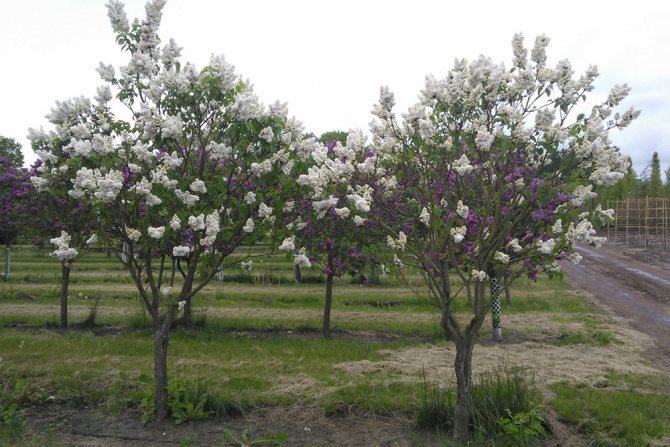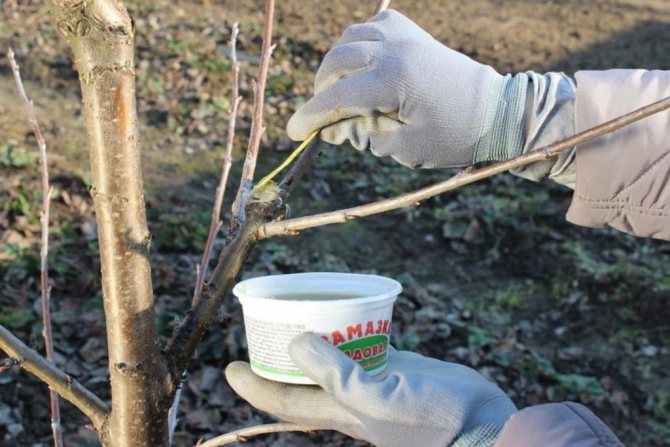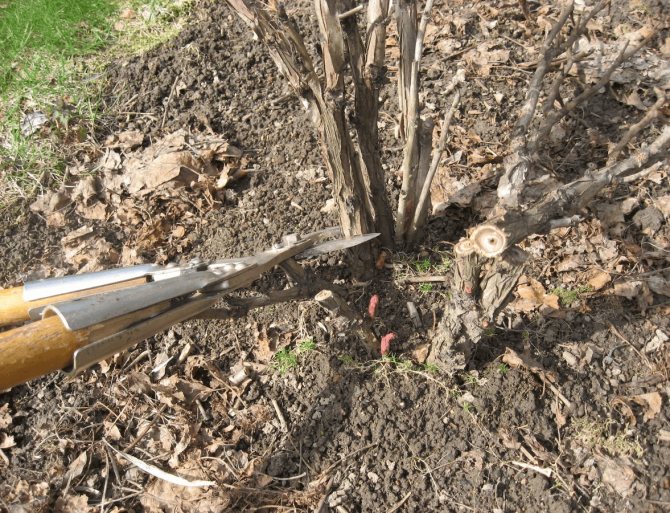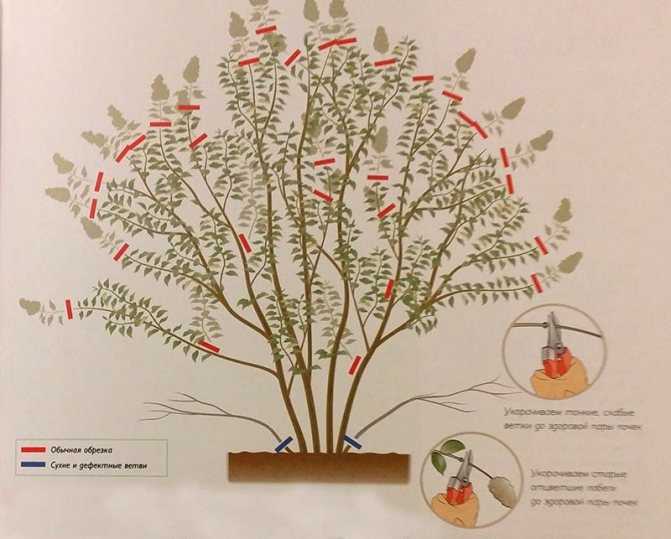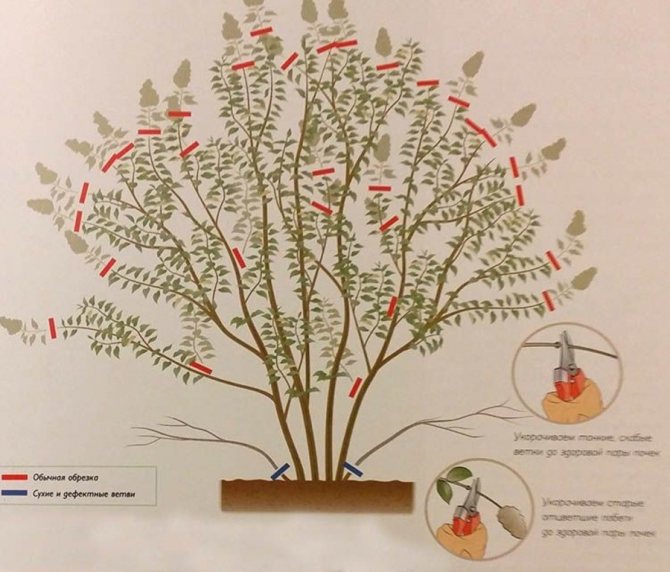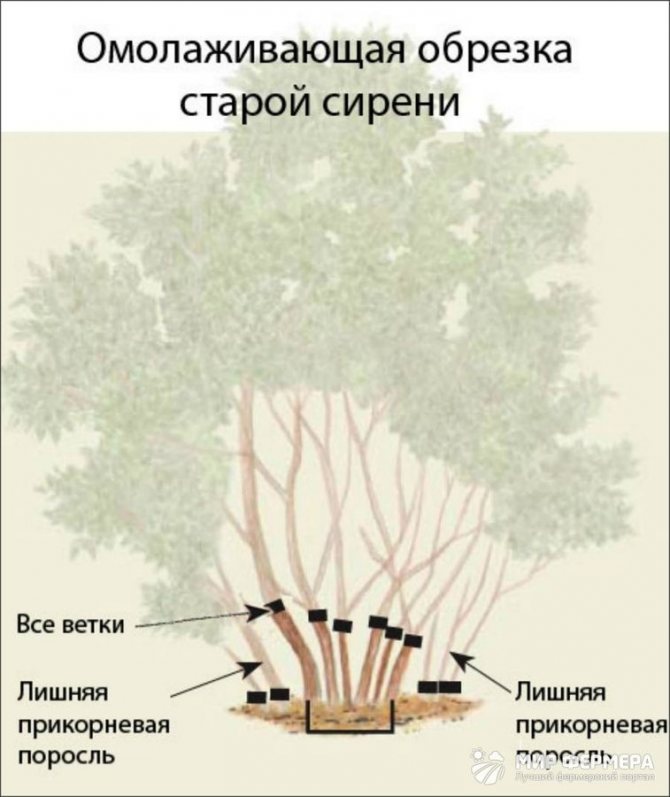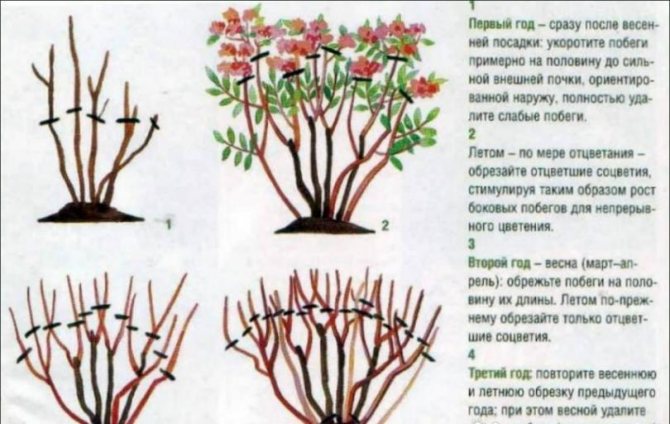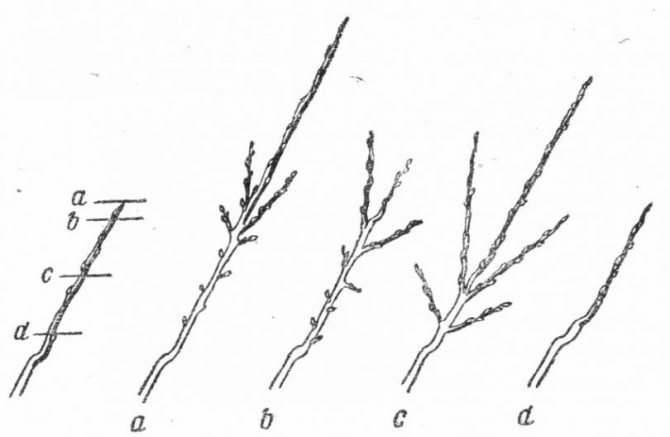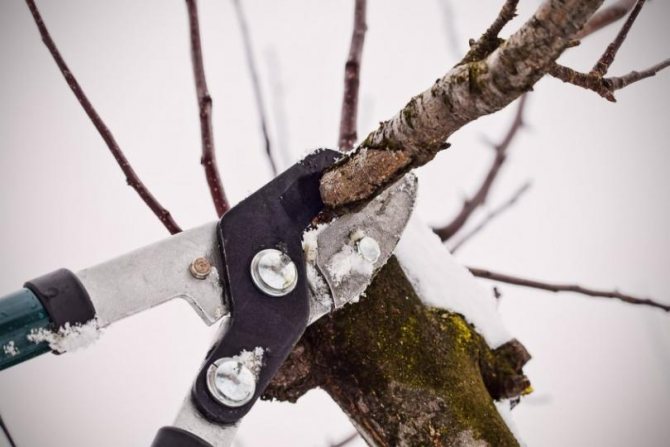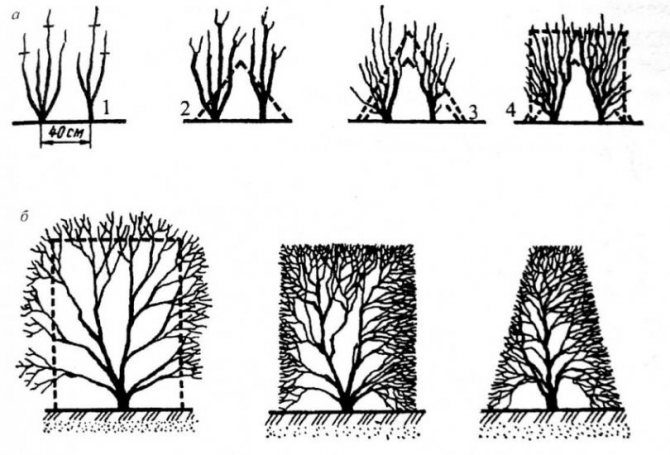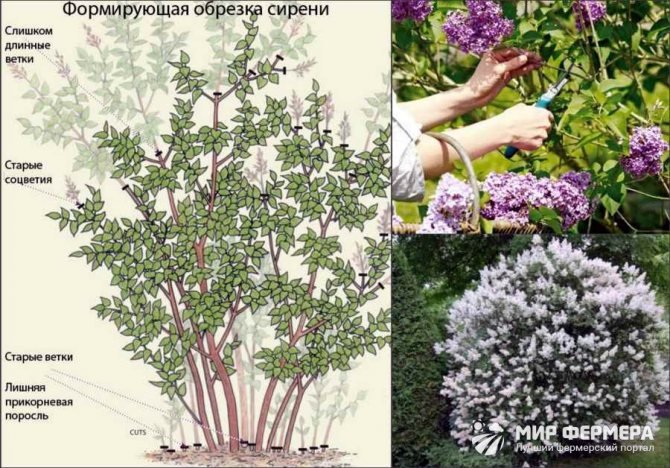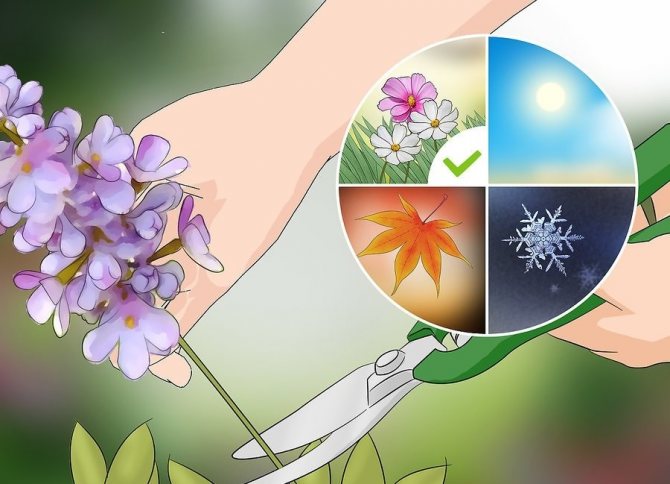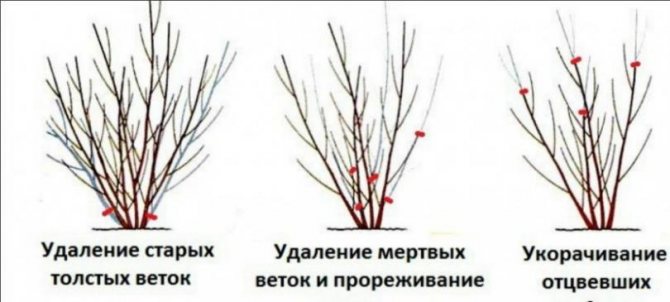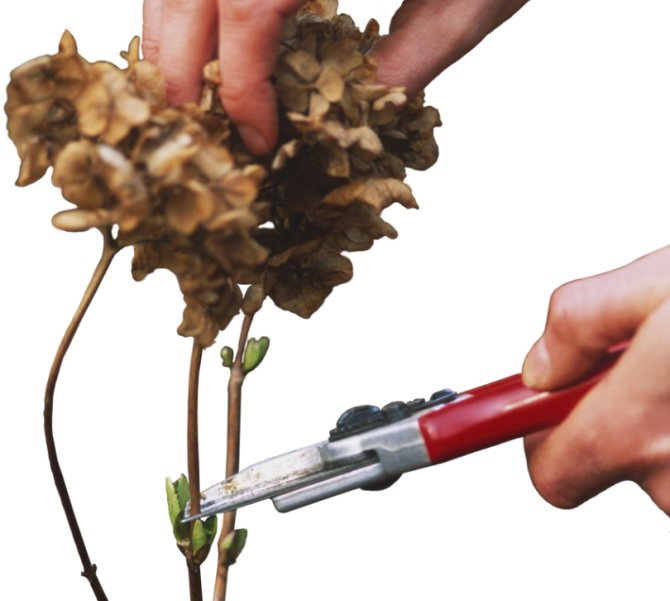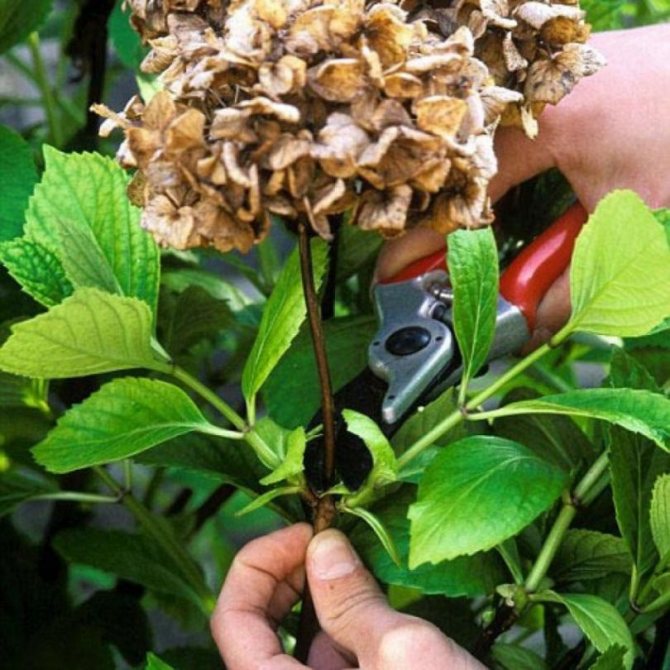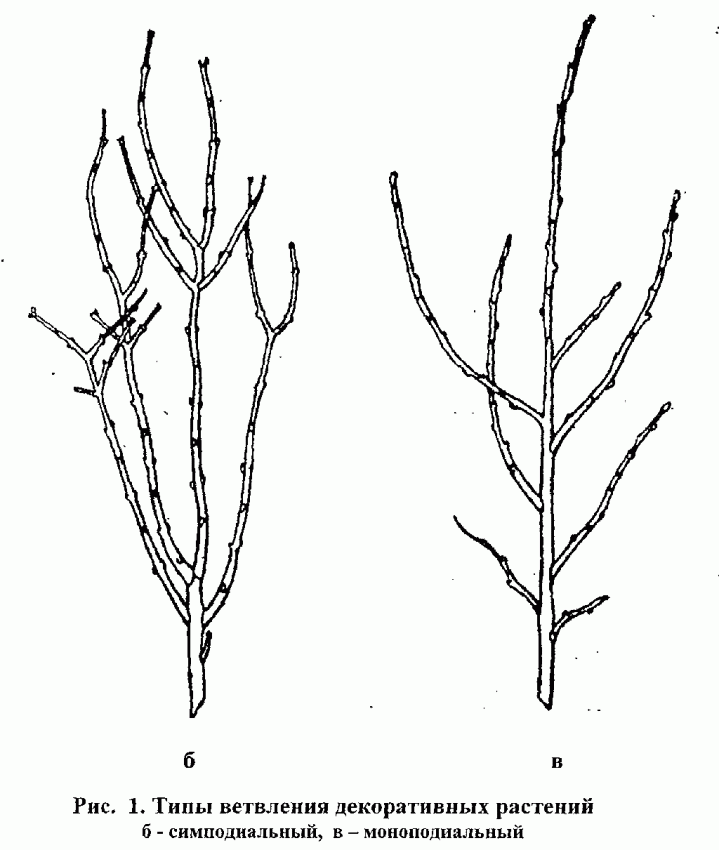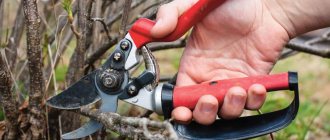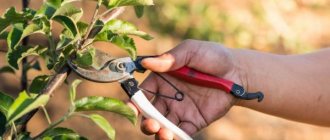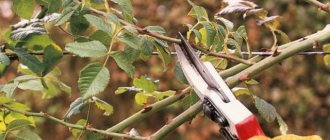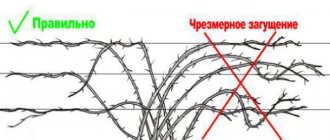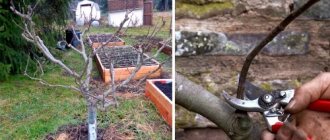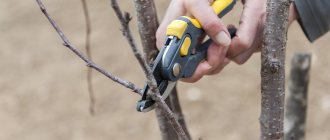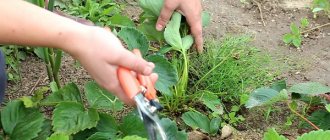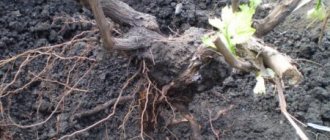Lilacs can be found in almost every flower bed, because this unpretentious shrub has a high decorative effect, and its lush fragrant inflorescences will adorn any garden. But to preserve these qualities, it is necessary to regularly prune lilacs, both to form a crown of the correct shape, and to rejuvenate old plants.
This article describes in detail the technique of carrying out the procedure, depending on the season and age of the bush. You will learn how to properly remove lilac branches in spring and autumn, and what activities need to be carried out before and after flowering, and photos and videos will help you master the skills necessary for the procedure.
- Annual pruning
- Annual pruning
Why cut bushes
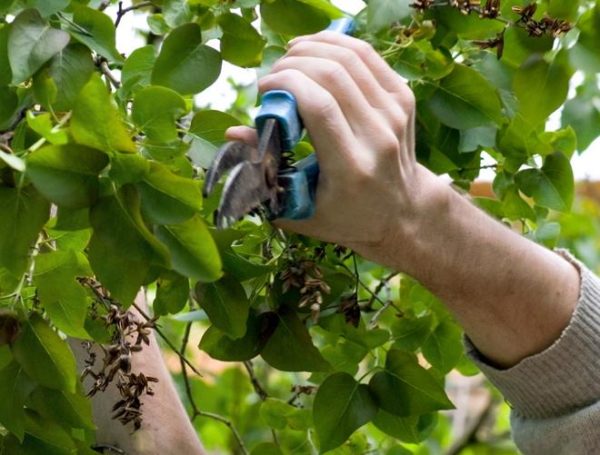
Pruning lilacs in the fall is carried out with the main purpose of rejuvenating the bush and obtaining abundant flowering in the next season. If you refuse to manipulate the bush will stretch in height, the flowers are crushed, the leaf mass will lose its rich green color.
Subject to the basic rules of manipulation, the gardener can:
- rejuvenate the existing bush;
- form a sweeping crown;
- stimulate the growth of shoots in the right direction, without thickening;
- will provide lush flowering;
- will remove all damaged shoots.
In the first 2-3 years after planting the seedling, pruning is not required, because the bush grows slowly. Only a sanitary haircut is carried out, including the removal of damaged branches for the prevention of fungal diseases. In the fall, you can cut the branches into 4 pairs of leaves for better branching.
If the gardener is waiting for flowering next season, it is worth refusing to prune young branches, because the buds form on them in early spring. Removal will cause poor flowering.
How to prune in the fall
Autumn pruning - formative, is carried out in order to remove root shoots, affected, broken stems and diseased shoots. The gardener should remember that on the eve of winter, the cut volume should be no more than 20% of the total aboveground plant mass, otherwise active growth of root shoots in autumn is possible. All young shoots will inevitably die in winter, which will cause infection of an adult bush.
Before starting the operation, you need to roughly create a model of the plant after it. It is important to determine what kind of lilac should be in the garden - sprawling, compact, tall or not very. To create a lush crown, you need 6-8 main shoots. If the bush is planned to be tall, but not thick, 3 central ones are left. To maintain symmetry when pruning, leave even branches growing in different directions. Failure to comply with this rule will lead to one-sidedness of the bush, which is very difficult to correct, the option of salvation is total cutting in winter.
In the first year after planting, all weak, crooked and damaged shoots are removed from the seedling. If the plant has two branches of the same size growing in the same direction, one of them is cut off.The branches extending from the base of the plant are shortened by a third or half their length. Ideally, all the shoots of the plant should be the same length.
In the fall of the second year, the first, full haircut is carried out. The main branches are not touched. Shoots grown on skeletal branches are removed, leaving only strong ones, maintaining uniformity. General pruning removes one third of the growth. They work according to the same scheme in subsequent years, until the desired crown of the bush is obtained.
Pruning schemes
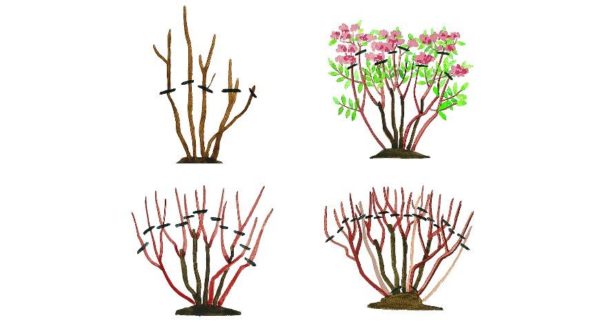

To trim lilacs, 2 schemes are used. The first implies the formation of the crown, and the second - the removal of fading flowers, with the rejuvenation of the branches. Pruning the crown in order to activate its growth and gain mass is recommended to be carried out in the spring, sacrificing flowering in the season. The largest branches are pruned three times. Immediately after formation, empty areas may appear in the crown, visible after the lilac bloom - this is normal.
Pruning of inflorescences is carried out immediately after the end of flowering. It is necessary for setting flower buds for the next season. If the faded inflorescences are not removed, the bookmark will not occur and flowering will be poor or not at all.
Required tools
To carry out pruning, you need:
- secateurs;
- double-sided pruning shears;
- lopper;
- scissors;
- garden file;
- gloves;
- garden knife;
- padded knee pads.
When choosing tools, pay attention to:
- maximum pungency;
- safety;
- ease of use;
- tapered edges of the blades;
- strength and lightness.
Before work, all tools are processed to prevent the spread of pests, bacterial, viral and fungal plants in the garden.
General rules for pruning lilacs
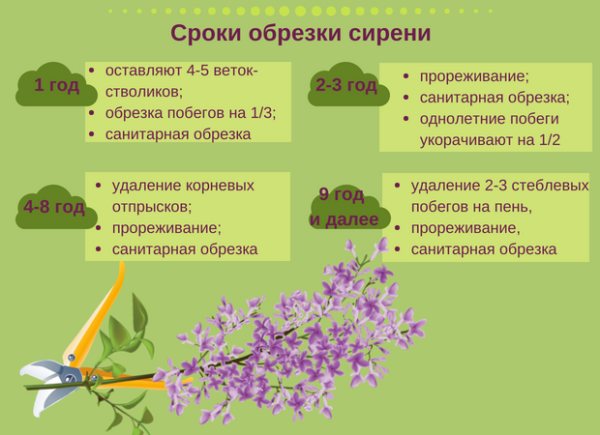

The list of basic rules and recommendations includes:
- sanitary pruning is carried out 3 times per season: in summer, spring and autumn, all damaged branches are removed;
- cutting off large trunks, the cut must be covered;
- you do not need to level the crown at the same height at once, you can do this once a year, immediately after flowering;
- anti-aging pruning is carried out annually;
- a regulating haircut will allow you to get lush flowering every year, for this, the skeletal branches are pruned at different levels;
- it is forbidden to break out peduncles;
- no more than 40% of the blossoming branches can be cut into bouquets, otherwise flowering will not occur next year, the plant will increase the crown and leaf mass.
Compliance with the listed rules will allow you to get abundant flowering on a healthy, evenly formed shrub.
How to prune lilacs
How to properly cut lilacs is difficult to say unequivocally. The manipulation technology depends on the expected results.
Before flowering
In early spring, the bush is thinned out carefully. Massive branch removal will result in no flowers in April. At this time, they carry out sanitary cleaning and thinning of the growth. It is important to remove all broken and blackened branches so that the appearance of the bush does not deteriorate after the growth of green leaves and an array of flowers.
During flowering
Do not be afraid to cut flowers to create bouquets - this is the main rule of lush bloom next season, but you should not be zealous either. Removing the flowering mass can delay flowering if moderation is not observed.
When cutting flowering bouquets, the array of shrubs is thinned out and young branches growing inward are removed. For cuts, use sharp scissors or pruning shears.
After flowering
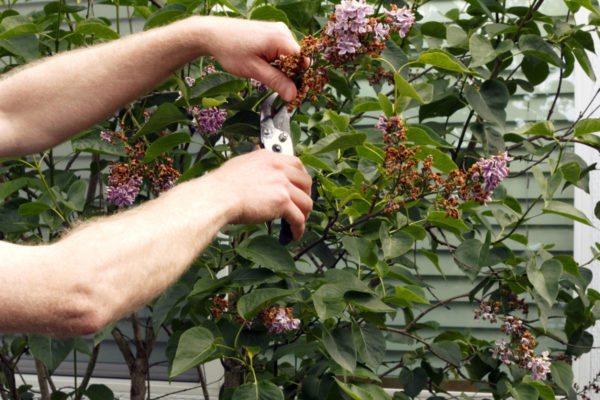

Massive pruning is done after flowering is complete. Manipulation requires compliance with the rules:
- carrying out immediately after flowering;
- skeletal branches and shoots are removed;
- cut off faded flower stalks to prevent seeds from ripening.
Large cuts are coated with paint or linseed oil, without this, the branches can rot.
Thinning the bush
Held in the spring. Branches are removed from the shrub, heading into its depths. Root shoots are removed.Can be carried out in the fall, but until temperatures drop below 0 degrees.
Sanitary pruning
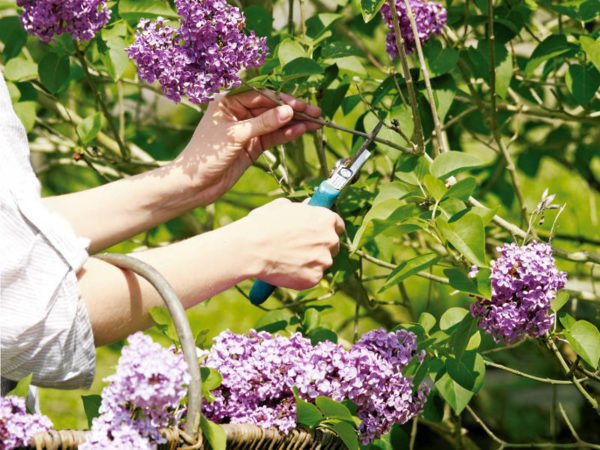

The purpose of the operation is to remove:
- dry, crooked branches;
- competing, broken, crooked shoots;
- branches and trunks cracked with age;
- shoots thickening the crown;
- the remainder of the faded inflorescences.
The manipulation is carried out in the fall before the onset of frost. Can be carried out immediately after flowering.
Formative pruning
Forming a lush shrub or tree with a uniform crown is a long process that requires a lot of time and effort. It takes years to obtain the desired parameters, because cutting off the branches in large quantities is to the detriment of the plant.
- Start preparing for the second year of growth of the bush. Leave 5 main stems. The rest are cut off at the base and cut off. The top of the left branches is cut to one level.
- After a year, the branches are treated, leaving developed shoots of the upper part of the bush. The growth directed inward is removed along with the damaged parts of the future crown.
- The crown manipulation described in this step is repeated annually.
Stamp trimming


Stamping requires the removal of all but one stem. In the first year of life, the seedling is pinched to the height of the branching, optimally 0.5-0.7 m. Further, they work with the crown according to the principle of formative pruning. After leaving 4 main shoots, and then, annually thin out the shoots on them. So, continue until the required shape, crown diameter and height are obtained.
Anti-aging pruning
Autumn lilac care often includes anti-aging treatments. They are required by overgrown shrubs. The process involves the removal of all plant trunks to a level of 15-30 cm (depending on their condition). If there is overgrowth, on the eve of cold weather it is removed to prevent decay. Sections are treated with linseed oil. In the spring, young shoots will wake up at the bush - a full-fledged bush needs to be grown from them.
When is the best time to prune lilacs: in spring or autumn
Spring manipulation has advantages, but it is impossible to say that pruning is better done in spring, in view of the following facts:
- the plant, due to the abundant, unnecessary mass of shoots, does not receive nutrients in winter;
- exposed to various diseases in cold weather;
- will not bloom in spring.
Spring pruning is good when you need a quick set of leaf mass, in the case when the lilac is sick for a long time and cannot accumulate strength. In this case, the shrub should not be allowed to bloom. In springtime, when the plant is blooming, pruning a healthy bush means creating cut, bouquet arrangements for home decoration.
Bush care after pruning
After the autumn haircut, watering is minimized, the plant is systematically prepared to reduce temperatures. Excess moisture in the root system is destructive. Top dressing of lilacs in autumn is not carried out. In regions with a significant decrease in temperature, soil mulching is carried out. The composition of the mulch will provide additional plant nutrition and act as fertilizers.
After pruning, the lignified part of the plant should be inspected for rot and pests. Eli violations are present, processing is carried out before frost.
Time to board
Favorable and optimal period for planting lilacs - from late August to late September. The plant at this time is already on the threshold of dormancy: the growth of shoots stops, sap flow slows down. The ground is still well warmed up. The seedlings will have time to root well and get ready for wintering.
It's important to know
The presence of foliage on seedlings can mislead you: the leaves of lilacs last until frost and retain their green color. When the leaves have fallen off, it may be too late to start planting.
If you managed to plant the plant on time, your leaving is minimized: abundant watering immediately after planting and one or two more moderate watering before the onset of frost will be enough (if the weather is dry and there is no rain).
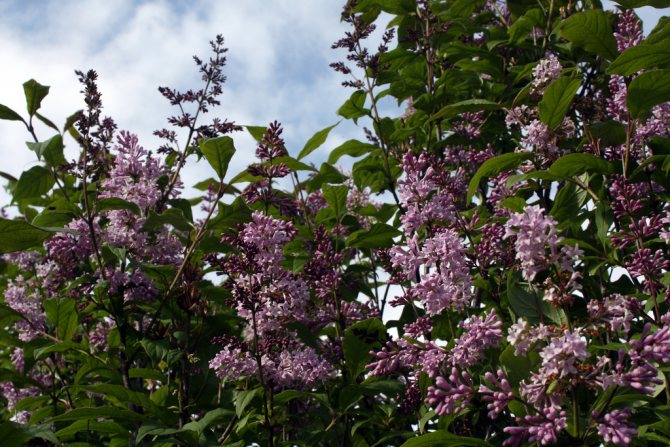

Common lilac
Description
How to prune lilacs? In order for the lilac to bloom profusely and the shrub has a beautiful, symmetrical shape, it must be cut off annually, but do it right. The optimal time for the procedure is mid-spring and early summer, after the flowering of the bush has passed.
Pruning is done in order to rejuvenate a bush or tree in order to stimulate the further growth of flowers and shoots, as well as to form a beautiful top and prevent the development of various kinds of fungal diseases.
When to prune
Lilac pruning can be done all year round. The choice of the season depends on the purpose of the procedure. The most common pruning periods are:
- before the flowering of the shrub;
- during flowering;
- after flowering;
- anti-aging.
The first procedure is carried out in early spring. Its purpose is to remove branches damaged during autumn and spring, as well as those that are knocked out of the general shape. However, pruning the tops of the branches before flowering is not recommended to avoid removing the buds.
The second procedure is performed from mid-spring to early summer, when the bush is in bloom. The blossoming buds are cut to form bouquets. It is also recommended to immediately remove small branches that shade other plants and begin to get confused.
The third procedure is carried out at the beginning of summer, after the lilac bush has faded. It is necessary to cut off all branches with faded buds, as well as dry and damaged ones.
The fourth procedure can be carried out during the summer or early fall. Since rejuvenation is the most cardinal method of cutting, performing which, you should not worry about removing the formed kidneys.
Watering
Lilacs are not demanding for watering, most species and varieties are drought-resistant. Abundant watering is required only after planting the seedling. If it was planted under unfavorable conditions (in spring), then throughout the summer it will also be necessary to monitor the plant, water it as the soil dries up and spray it with water if the foliage loses its elasticity.
The established plants are watered only during the flowering period, if at this time it is hot dry weather. If the summer turned out to be sultry and dry at all, from time to time it is good to water the lilacs both under the root and from above - to make her a "shower" from a hose. Closer to August, watering is stopped. When the weather in summer is not too dry and there are occasional rains, lilacs will have enough moisture received with precipitation.
During flowering, one of the additional types of care for lilacs is picking June beetles from it. These are large shiny beetles of emerald green color. They very willingly feed on lilac flowers, devouring its inflorescences and making them very unattractive. Therefore, in order to preserve the decorative effect of the shrub from the beetle, we have to fight.
How to properly prune lilac bushes
As mentioned above, you can cut lilac bushes for different purposes throughout the year, however, the most favorable and correct period is spring or summer, after the lilac has faded. It is necessary to prune faded buds and branches for the winter so that next time the flowering is more magnificent.
During the first two years after planting, a young and fragile lilac bush grows very slowly, so it is not required to cut it. However, you can do moderate pruning and cut the tips of the green branches so that three or four pairs of lower buds are retained on the branch.
The annual procedure is performed according to the following scheme:
- During the period when the inflorescences are fully blooming, it is necessary to cut the lilac flowers.With the help of a pruner, you need to cut off the blossoming buds, making a cut at the very base of the inflorescence.
- After removing the blossoming flowers, it is necessary to cut off the faded inflorescences in the same way. If this is not done, the forming seeds will continue to take energy from the bush, which is necessary for further growth.
- The next step is to adjust the length of the branches. It is necessary to examine the entire bush (or tree), select the longest branches and use hand scissors to shorten them to the size of the adjacent branches. The cut is made near the nearest pair of side shoots. If there are no lateral shoots on the branch at the base, then the cut must be made not far from the node or buds, from which new shoots will have to grow.
- It is necessary to thin out the lilacs so that the sun, fresh air evenly falls on all branches, and also so that the tree spends less energy on processes that are no longer beneficial. First of all, withered or dried branches are cut, as well as darkened, flabby or damaged branches. It is necessary to cut off old branches at the base.
Pruning in late summer or autumn is undesirable, since the procedure serves as an impetus for the formation of new buds for flowering next year. Pruning branches in a later period may cause cutting off parts with already formed flower buds, after which there will be no abundant flowering next year. If you prune in winter, then next year the lilac bush may not bloom at all.
Bush formation
It takes more than one year to form a lilac bush, so pruning must be done annually, adhering to a certain idea of shaping the crown. It is recommended to start bush pruning no earlier than the plant reaches three years of age.
The principle of the procedure is as follows:
- The first pruning is the most time consuming, during which you will have to get rid of most of the branches, leaving three or four shoots. It is necessary to cut off old, weak, crossing and clinging branches to each other. In addition, the shoots should be directed in different directions, therefore, if two good branches are found growing side by side and directed in the same direction, then one should be cut off. All remaining branches should be approximately the same length.
- When carrying out the second pruning, it is necessary to pay attention to the top of the bush, on which by that time the branches should appear on the left branches. It is necessary to remove weak branches and those that do not grow up, but to the side.
- During the third pruning and all subsequent ones, it is necessary to repeat the actions of the first procedures, removing weak shoots and maintaining the selected shape of the bush.
To maintain a beautiful shape and create favorable conditions for lush flowering, you need to systematically thin out the bush, preventing the growth of a large number of branches and their plexus.
Stamp trimming
In order to get a beautiful lilac tree, you must give preference to standard pruning. A miniature tree looks more harmonious and takes up less space. The stages of pruning lilacs are as follows:
- The first procedure is performed in the first year after planting. It is necessary to cut off the side branches, leaving only the central part of the lilac intact. During the year, you need to systematically remove all young shoots that grow on the side of the stem.
- The second procedure is to prevent the plant from stretching too far up. It is necessary to remove the top so that the shoots begin to grow to the sides. The branches need to be thinned out, leaving the 4 strongest and healthiest shoots.
- The third procedure, like all subsequent ones, consists in maintaining a given shape by cutting off regrown and weak shoots.
The recommended height of lilac for stamping should not be higher than one meter and below half a meter.In the first case, exceeding the height threatens to complicate pruning, in the second - to get an ugly plant.
Lilac rejuvenation
If the shrub grows too much in different directions without proper care, then many old, dry and damaged branches appear due to lack of sun and lack of air circulation. In order to carry out rejuvenation, it is necessary to cut off the old bush according to the following scheme:
- The procedure should be done in the spring before the lilac begins to bloom. In the case of rejuvenating pruning, there is no need to spare the branches for fear of removing the formed buds.
- It is necessary to check if the bush is grafted. At the grafting site, the thickness of the trunk, the color or pattern of the bark should change. If the lilac is vaccinated, then circumcision can only be done above the vaccination level.
- Old branches need to be cut or cut without leaving any stumps. Strong and relatively young branches should be cut in half or one third.
- The subsequent procedures are standard and annual, during which it is necessary to correct and maintain the shape of the bush.
It will take one or two seasons to fully restore the lilac bush.
DIY var
Three ingredients are taken to prepare the var: rosin, wax, vegetable oil... For one part of rosin, two parts of wax and oil are taken. Rosin must first melt, add wax, then pour in oil, mix well and turn off the heat.
After cooking, the still hot var should be poured into water so that the mixture does not stratify. Then drain the water and leave the var to dry. Store under a lid. Many gardeners process the cuts with pharmacy brilliant green.
General rules for shortening branches
Regardless of the reason for shortening the branches of the lilac, whether it be stimulating further growth, thinning the crown or rejuvenating the bush, it is necessary to adhere to general rules so as not to injure the plant more, namely:
- The use of only a sharp and well-sharpened instrument is the key to a correctly performed procedure. The cut should be perfectly flat, without any loose fibers. Otherwise, the cut site will heal for a longer time, and, therefore, the flowering process will be postponed.
- Pruning lilacs should not be carried out during or after rain.
- It is necessary to make a cut over well-developed kidneys.
- Large branches must be cut in several approaches. First, with the help of a pruner, you need to remove the small side shoots, and then everything else.
- Of the 4 shoots, only one is required to be removed - the weakest one in order to stimulate further flowering and visually make the shrub or tree more neat.
- The cuts must be made at an angle so that there is no stagnation of moisture in them.
- Twenty minutes after the procedure, the largest sections must be treated with a sterile and waterproof putty with an antiseptic, for example, paint, garden varnish or brilliant green.
Sanitary pruning of lilacs for the winter is carried out in the fall. It includes the removal of diseased and dead branches, as well as root growth.
It is recommended to prune lilacs in mid-spring or early summer, after a period of flowering shrubs. You need to perform the procedure with sharp garden shears or pruning shears, making cuts at an angle above the already developed buds. It is undesirable to touch a young shrub for the first couple of years, while its branches are too thin and weak. Pruning of the lilac bush is carried out in order to increase the abundance of flowering next year, as well as to give a beautiful shape.


To preserve the decorative effect of lilac, which consists primarily in lush flowering, it is necessary to regularly cut the shrub.If this is not done, then the flower brushes are formed much less, since the root system cannot cope with the excess amount of branches and the plant simply does not have enough energy to form flowers.
Slicing processing
After trimming, the wounds heal over time. But this process is detrimental to lilacs, so it is better to process the sections immediately. Thick branches are especially vulnerable, as torn cuts may prevent them from tightening.
After shortening or removing, the cut must first be processed with a very sharp knife, then wait a few hours. But don't wait if it's damp outside. It is necessary to immediately cover the place of the cut with garden pitch. Var prevents pests from getting to the cut sites. It will help to quickly heal all wounds.
The need for autumn pruning of lilac bushes
Most gardeners prefer to prune lilac bushes in early spring - before sap flow or immediately after flowering. It is not recommended to do this in autumn, as you can remove the forming flower buds. But the autumn pruning of plants is much easier to tolerate, since they are already preparing for wintering and are at rest. Therefore, subject to certain rules for lilacs, this procedure will be very useful.
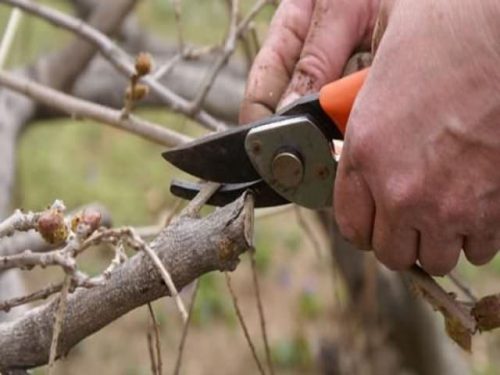

Autumn pruning is more easily tolerated by shrubs.
Pruning in the fall is required for the following tasks:
- laying more flower buds on the remaining branches;
- forming the crown of the desired shape;
- prevention of the appearance of insect pests and various diseases to which neglected bushes are more susceptible;
- rejuvenation of the bush.


Autumn pruning of lilacs is carried out with a sanitary, formative and rejuvenating purpose
Sanitary
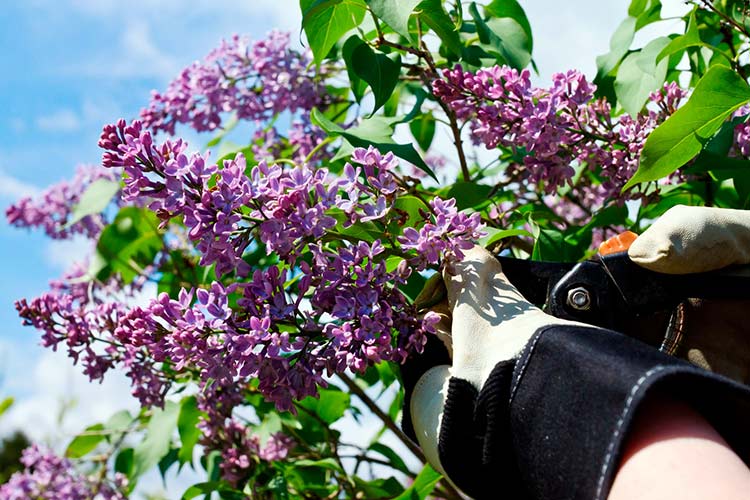

This type of procedure is aimed at getting rid of old, sick and damaged parts. It is from the sanitary stage that spring pruning begins.
The first step is to prune any damaged branches. Examine the bush and also remove the blackened shoots touched by the fungus. If these branches are not removed, they can become a source of infection.
You should also get rid of healthy branches if they thicken the crown, create unnecessary shading inside it. Frost-bruised branches also need to be cut off without fail - they are already weakened and often unviable.
The tip of the shoots should not be touched, since it is there that the buds blooming in the current season are located.
Autumn pruning technology for lilac bushes
In autumn, it is recommended to carry out measures for pruning lilacs at least 3-4 weeks before the onset of stable frosts. You can prune shrubs according to several schemes.
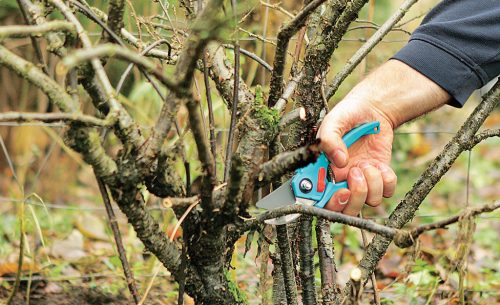

Autumn pruning of lilac can be carried out according to different schemes
Video: lilac pruning scheme
Sanitary pruning
Every autumn, while preparing lilacs for winter, you need to carefully examine all the bushes in order to identify and remove:
- dry, broken and crooked branches;
- shoots growing inside the bush, as well as competing and intersecting;
- old, cracked and lichen-covered branches;
- superfluous and thickening the crown of the young growth;
- faded brushes, if they were not cut off in the summer.
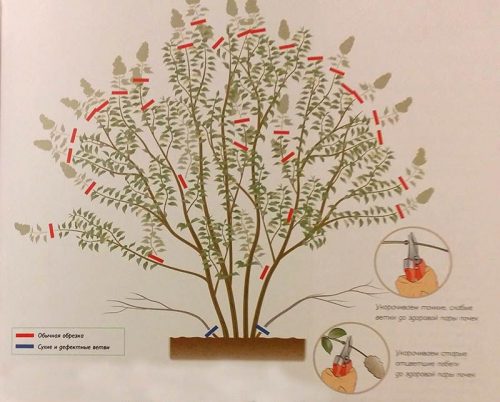

With sanitary pruning, all unnecessary, unnecessary, old, broken and diseased branches are removed
If the plant has been grafted, then all the shoots below the grafting site must be cut out.
Video: autumn pruning of lilacs
Forming pruning
The lilac crown is formed after the third year of life for several years:
- Choose no more than 4–5 strong, strong shoots, well located in space. All the rest are carefully cut down near the ground. The tops of the skeletal branches left are pruned at the same height.
- A year later, they work with branches on skeletal branches. Leave the most developed shoots, which are in the upper tier and directed outward. The branches going inside the bush, intersecting and thickening the crown, must be cut out.
- The next season, a similar operation is carried out, trying to avoid visible voids in the crown or excessive thickening of branches.
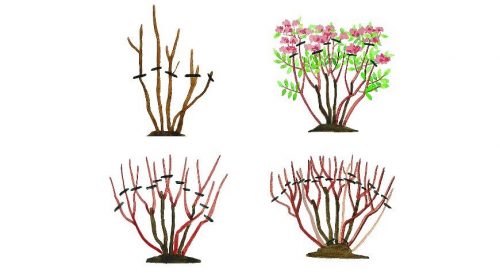

Formative pruning of lilacs is carried out after three years
In the future, it remains only to maintain the resulting shape.
I like to shape the lilac into a tree. For this, I leave one central branch, which will be the trunk. I remove all the rest. Upon reaching the desired height, I pinch the stem, stopping its growth. Then I select four strong, outward branches and further work with them. I constantly get rid of unnecessary overgrowth.
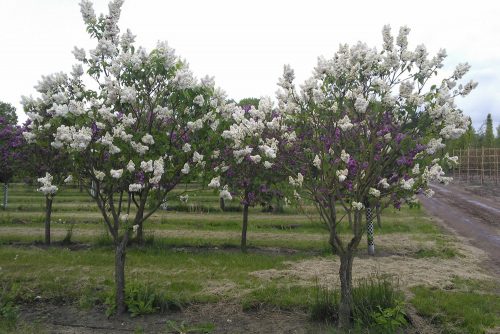

Standard lilac is formed in the form of a tree
Video: we form a standard lilac
Pruning anti-aging
A neglected and old bush (over 10-12 years old) needs rejuvenation:
- Remove old, diseased, dry, thin, broken and other unnecessary branches.
- Leave a few (4-5) shoots, which are cut to 10-15 cm.
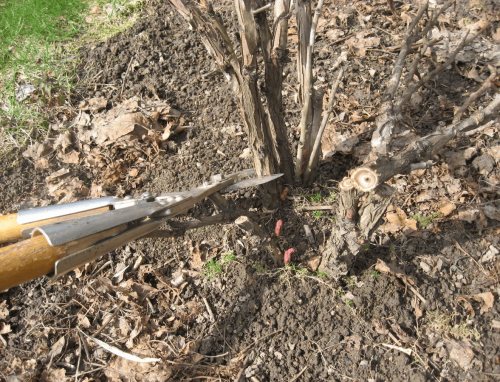

Only 4-5 branches are cut, leaving stumps of 10-15 cm, the rest are cut out completely
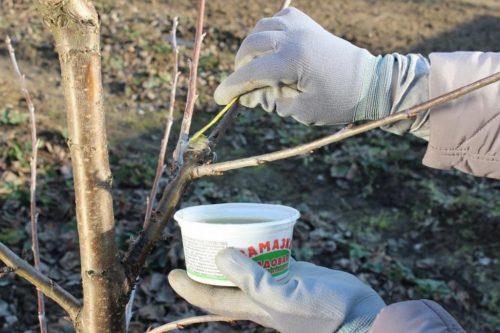

Places of cuts should be treated with garden putty to avoid infection.
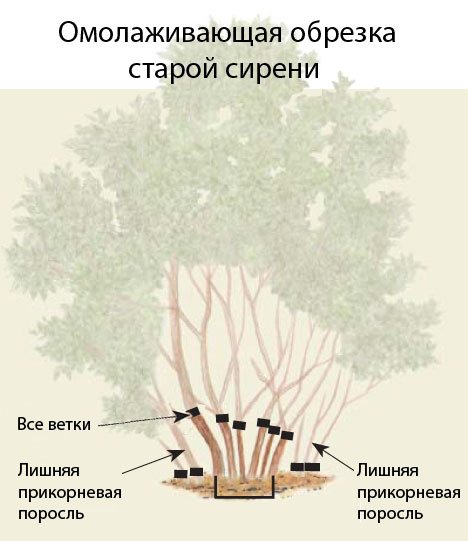

With radical rejuvenating pruning, all shoots are cut
Video: rejuvenating pruning of an old lilac bush
Preventive overgrowth removal
This event should be carried out annually, after the foliage has fallen, during which it is necessary to cut the following:
- all basal vegetation;
- stems with damage or signs of disease;
- densely growing branches;
- Shoots, which, in the course of growth, began to curl up inside the bush.

